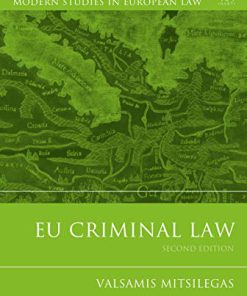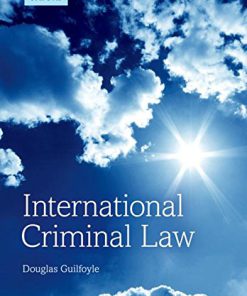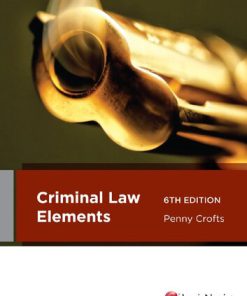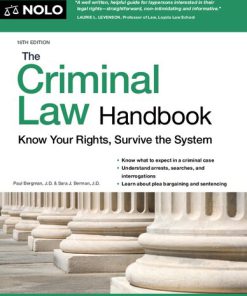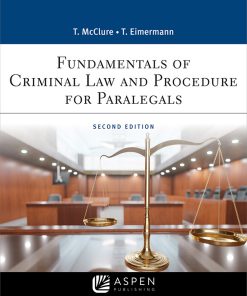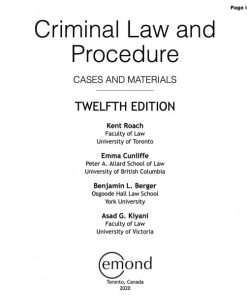Criminal Law 13th Edition by Thomas J Gardner ISBN 9781305966369 1305966368
$50.00 Original price was: $50.00.$25.00Current price is: $25.00.
Criminal Law 13th Edition by Thomas J Gardner – Ebook PDF Instant Download/Delivery: 9781305966369 ,1305966368
Full download Criminal Law 13th Edition after payment
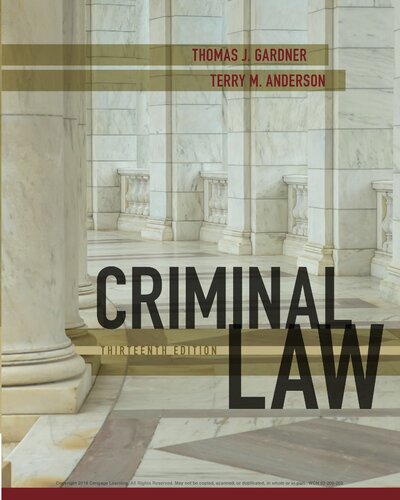
Product details:
ISBN 10: 1305966368
ISBN 13: 9781305966369
Author: Thomas J Gardner
Criminal Law 13th Edition Table of contents:
Chapter 1. Criminal Law: Purposes, Scope, and Sources
Important Concepts in Criminal Law
Substantive Criminal Law
Criminal Law and Moral Law
Goals and Purposes of Criminal Law
The Permissible Scope of Criminal Laws in the United States
The Use and Limitations of the Police Power to Maintain Public Order
The Principle of “No Punishment without a Law for It”
Classifications of Crimes
Felony and Misdemeanor
General Constitutional Limitations on Criminal Laws
Ex Post Facto Laws
Bills of Attainder
The Second Amendment and Gun Control
Due Process, “Void for Vagueness,” and the “Overbreadth” Doctrine
Status Crimes
Equal Protection of the Laws
Sources of Criminal Law
Common Law Crimes
Statutory and Administrative Crimes
Learning Objectives Summary
Key Terms
Case Analysis and Writing Exercises
Chapter 2. Jurisdiction
Jurisdiction of the Federal Government to Enact Criminal Laws
The Commerce Clauses
Federal Crimes Frequently Used to Support State and Local Enforcement
The Federal Domain—One-Third of America
Nation-To-Nation Jurisdiction
International Criminal Law
Jurisdiction of the Sea Approaches to the Continental United States
The Crimes of Piracy, Felonies Committed on the High Seas, and Offenses Against the Law of Nations
The Military, Martial, and War Powers Jurisdiction of the Federal Government
Jurisdiction of Military Courts
When U.S. Citizens or Military Are in a Foreign Country
The Use of National Guard Troops and Curfews to Assist Police with Riots and Disorders
The Crime of the Improper Use of National or State Guard Troops
Indian Tribes within the United States
Learning Objectives Summary
Key Terms
Case Analysis and Writing Exercises
Chapter 3. Essential Elements of a Crime
True Crimes and Strict Liability Crimes
Crimes Requiring Proof of Mental Fault
Actus Reus: The Forbidden Act or Omission
Mens Rea: The Guilty Mind
Proving Criminal Intent or Criminal State of Mind
The Requirement of Scienter
The “Willful Blindness” Rule
The Motive for Committing a Crime
Strict Liability Crimes
Strict Liability Laws that Seek to Protect Children
Proximate Cause or Causation
The Ancient Year-and-a-Day Murder Rule
Possession Alone as a Crime
The Possession of Illegal Contraband Inference
The Use of Presumptions and Inferences in Criminal Law
Functions of Presumptions and Inferences
The Presumption that All Persons Are Sane, Normal, and Competent
Learning Objectives Summary
Key Terms
Case Analysis and Writing Exercises
Chapter 4. Criminal Liability
Preliminary, Anticipatory, and Inchoate Crimes
Solicitation or Incitement to Commit a Crime
Conspiracy to Commit a Crime
The Requirement of an Overt Act
The Crime of Attempt
Impossibility in Attempt Cases
Parties to the Principal Crime
Theories of Criminal Liability
Liability for Crimes Other than the Planned and Intended Offense: Conspiracy
Post-Crime Offenses
Learning Objectives Summary
Key Terms
Case Analysis and Writing Exercises
Chapter 5. Criminal Responsibility and the Capacity to Commit a Crime
Ancient Concepts of Criminal Responsibility
Infancy and Criminal Responsibility
The Juvenile Court System
The Insanity Defense
Insanity at the Time of the Criminal Incident
Tests Used to Determine Insanity
The M’Naghten Case and the “Right and Wrong” Test
The “Product-of-Mental-Illness Rule” and “Irresistible Impulse”
The Model Penal Code “Substantial Capacity” Test
The Plea and Verdict of Guilty but Mentally Ill
Mental Conditions that Do not Satisfy the Insanity Defense
Voluntary Intoxication
The Defense of Diminished Capacity
The Requirement of Competency to Stand Trial
The Criminal Liability of Corporations
Learning Objectives Summary
Key Terms
Case Analysis and Writing Exercises
Chapter 6. The Law Governing the Use of Force
Self-Defense and the Defense of Others
The Use of Deadly Force in Self-Defense or the Defense of Others
Loss of Self-Defense Privilege for a Wrongdoer or an Aggressor
The “Castle” Doctrine and the Minority Duty-to-Retreat Exception to that Doctrine
Battered Women and Domestic Homicides
The Use of Force in the Defense of Property
The Use of Force in Making an Arrest
Using Reasonable Force to Obtain Evidence of Drunk or Drugged Driving
Standards for the Use of Deadly Force Established by the U.S. Supreme Court
Use of Force in Resisting an Unlawful Arrest
The Use of Tasers and Other Force in Traffic Stops
Disciplining Children
Learning Objectives Summary
Key Terms
Case Analysis and Writing Exercises
Chapter 7. Other Criminal Defenses
Affirmative Defenses
Immunity as a Defense
Diplomatic Immunity
Legislative Immunity
Witness Immunity
Mistake or Ignorance of Fact as a Defense
Mistake of Fact Defense Allowed
Strict Liability Crimes and the Defense of Mistake
Mistake or Ignorance of Criminal Law
Intoxication or Drugged Condition as a Defense
Duress, Coercion, or Compulsion as a Defense
Necessity or Choice of Evils Defense
Can One Kill to save Oneself?
Alibi as a Criminal Defense
Alibi Notice Statutes
The Defense that the Defendant Was Acting under the Authority, Direction, or Advice of Another
The Defense of Double Jeopardy
The Times when Jeopardy Attaches
Prosecution by both State and Federal Governments
The Meaning of “Separate Offense”
Entrapment and Outrageous Government Conduct as Defenses
States Are Free to Write Their Own Rules for Entrapment
The Defense that Another Person Committed the Crime
The Right to a Speedy Trial as a Defense
The Statute of Limitations as a Defense
Learning Objectives Summary
Key Terms
Case Analysis and Writing Exercises
Chapter 8. Criminal Punishments
Punishments Used in Early England
Practices Used in England to Avoid Severe Penalties
Punishment Used in Early America
The Constitutional Limitation on Punishment
Proportionality in State Sentencing Laws
Sentencing and Jury Trials
Corporal Punishment
The Use of Corporal Punishment in Schools
The Use of Corporal Punishment in Prisons
Capital Punishment
Death Penalty Laws After Furman V. Georgia
Imprisonment as Punishment
Can Indigents Be Held in Jail to Work Off Their Money Fines?
Fines and Forfeiture as Punishment
Career Criminals and the Repeat Offender
“Three Strikes” Laws
Learning Objectives Summary
Key Terms
Case Analysis and Writing Exercises
Chapter 9. Free Speech, Public Order Crimes, and the Bill of Rights
Belief—Speech—Action: When Speech May Be Regulated
The “Clear and Present Danger” Test
Fighting Words
When Does Vulgar, Insulting Language to a Police Officer Constitute Fighting Words?
Convictions Upheld
Convictions Overturned
Obscene Communications
Inciting and Urging Unlawful Acts
Defamation: Libel and Slander
Symbolic Speech and the First Amendment
Flag Burning and Cross Burning as Symbolic Speech
Threats of Violence as Crimes
Using the U.S. Mail, Telephones, the Internet, or E-Mail to Threaten Another Person
Bullying: Not a Crime, but It Can Consist of Criminal Conduct
Loud Noise or Nuisance Speech
Regulating the use of Public and Private Places
The Crimes of Unlawful Assembly and Rioting
Obstruction of the Law Enforcement Process
Public Nuisances as Civil or Criminal Offenses
The Crime of Stalking and Violation of Protective Orders
Crime on City Streets
Gun Ownership and Registration Laws
Regulating Guns after Heller
The Free Exercise of Religion
The Right of Privacy
Learning Objectives Summary
Key Terms
Case Analysis and Writing Exercises
Part Two: Crimes Against the Person
Chapter 10. Homicide
Homicide in General
The Corpus Delicti Requirement
Proving Corpus Delicti in “No Body” Cases
Body Without Proof of the Cause of Death Cases
The Common Law “Born Alive” Requirement and the Crime of Feticide (Fetal Murder)
Proof that the Victim was Alive at the Time of the Defendant’s Unlawful Act
When Is a Person Legally Dead?
The Causation Requirement
Causation and Proximate Cause
The Year-and-a-Day Rule
Murder
Intent-to-Kill and Premeditated Murder
The “Deadly Weapon” Doctrine
Transferred Intent
Intent-to-Do-Serious-Bodily-Harm Murder
Depraved-Mind or Depraved-Heart Murder
Felony Murder
Manslaughter
Definition of Manslaughter
Voluntary Manslaughter
Heat of Passion Manslaughter
Imperfect or Unlawful Force in Self-Defense Charged as Manslaughter
Involuntary Manslaughter
Suicide, Assisting Suicide, and Euthanasia
Murder, Suicide, or Neither?
The Oregon “Death with Dignity” Law
Learning Objectives Summary
Key Terms
Case Analysis and Writing Exercises
Chapter 11. Assault, Battery, and other Crimes Against the Person
The Crime of Assault
Assault with a Deadly or Dangerous Weapon
Battery
Offensive touching under Sexual Assault and Sexual Battery Statutes
Sports Injuries when Force Exceeds the Rules of the Game
Other Physical Contact without Consent
Felonious and Aggravated Assaults and Batteries
Mayhem and Malicious Disfigurement
Hate Crime Laws
Child Abuse and Neglect
Offenses Against the Liberty of a Person: Kidnapping
Kidnapping and Hostage Taking
False Imprisonment
Parental Kidnapping or Child Snatching
The National Child Search Assistance Act
Family Violence and Disturbances
Domestic Violence and Women
Abuse of the Elderly
Violence in the Workplace
Road Rage: Violent Aggressive Driving
Learning Objectives Summary
Key Terms
Case Analysis and Writing Exercises
Chapter 12. Sexual Assault, Rape, Prostitution, and Related Sex Crimes
Sexual Relations in the United States Today
Rape or Sexual Assault
The Importance of Corroborative Evidence in a Rape Case
Possible Responses to a Threat of Rape
The “Force” Required in Rape or Sexual Assault
The Report of Rape Rule and the Effect of Delay in Reporting
Rape Shield Laws
Statutory Rape
The Crime of Incest
HIV and AIDS-Related Crimes
Laws that Require Registration for Sex Offenders (Megan’s Law)
Civil Commitment of Sexually Dangerous Offenders
Prostitution
The Crimes of Procuring, Promoting, and Pimping for the Practice of Prostitution
Crimes That Require Proof that the Crime Was Committed in a Public Place
Touching or Other Conduct Done to Arouse Sexual Desire
Protecting Children Against Sexual Exploitation: Child Pornography
The Federal Enticement Statute
Movies, Videos, and Photographs
“Sexting,” and Nude Photos of Children Taken by Family Members
Voyeurism and Other Criminal Invasions of Privacy
Learning Objectives Summary
Key Terms
Case Analysis and Writing Exercises
Part Three: Crimes Against Property
Chapter 13. Theft
General Property Concepts
Theft or Larceny
The Taking
Defining What Property Can Be Stolen
Property of Another
Intent to Steal
Shoplifting
Taking and Carrying Away in Shoplifting
Proving the Crime of Shoplifting When the Suspect Has Not Left the Store
The Requirement of Probable Cause Based on Personal Knowledge
Criminal or Civil Prosecution of Shoplifters?
Other Retail Theft Crimes
Fraudulent Use of Credit Cards
Credit Card Theft and Obtaining Credit Cards and Bank Cards for Fraudulent Use
Check Violations
The Crime of Uttering
The Crime of Forgery
Operations of Check-Forging Rings
Passing Forged Checks and Other Counterfeit Securities in Interstate Commerce
Check Kiting
Learning Objectives Summary
Key Terms
Case Analysis and Writing Exercises
Chapter 14. Robbery, Burglary, and Related Crimes
Robbery
Changes in Bank Robbery
Distinguishing Robbery from Theft or Larceny
Carjacking: A New Name for an Old Crime
Home Invasion Robberies
Purse Snatching, Pickpocketing, and Other Thefts from a Person
Extortion
Extortion by Intimidation
Burglary
Breaking
Unlawful Entry into Premises
The Dwelling House of Another
Nighttime
Intent to Commit a Felony
Proof of Burglary when Other Crimes Are Committed
The Crime of Trafficking in Stolen Goods
The Fence and Fencing Stolen Property
When Property Loses Its Character as Stolen Goods
Possession of Criminal or Burglary Tools
Destroying or Damaging the Property of Another
Trespass
The Crime of Defiant Trespass
Learning Objectives Summary
Key Terms
Case Analysis and Writing Exercises
Chapter 15. White-Collar Crime, Cybercrime, and Commercial Crime
White-Collar Crime
Fraud and Fraudulent Practices
Bank Fraud
Health Care Fraud
Intellectual Property Fraud
Fraud and Corruption in Government
Stock Market and Financial Market Frauds
Other Fraud Statutes in the Federal Criminal Code
The Crime of Identity Theft and False Identification Documents
Counterfeiting of Money and Commercial Products
Counterfeiting of Currency
Other Counterfeiting Problems
Computer Crime or Cybercrime
Arson
Essential Elements of Arson
Product Tampering
Learning Objectives Summary
Key Terms
Case Analysis and Writing Exercises
Part Four: Other Criminal Conduct
Chapter 16. Drug Abuse and Alcohol-Related Crimes
Drug Abuse
The Frightening Drug Problem
Illegal Drug Users
Drug Laws in the United States
The Uniform Controlled Substances Act
Types of Possession of Controlled Substances
To Convict of Possession of an Illegal Drug, Must the State Present a “Usable Amount” as Evidence?
Delivery of Controlled Substances
State–Federal Clash over the Medical Use of Marijuana
Controlled Substances Used in Religious Ceremonies
Drug Rip-Off Cases and Simulated Drugs
Criminal Liability for Drug-Induced Deaths
Possession or Sale of Drug Paraphernalia
Alcohol-Related Crimes
Alcohol’s Relation to Crimes and Deaths
Drunk Driving: The Criminal Homicide Causing the Most Deaths
Elements and Defenses in Drunk-Driving Prosecutions
“Booze It and Lose It” Laws
When Is a Person Driving, Operating, or “In Physical Control” of a Vehicle?
Learning Objectives Summary
Key Terms
Case Analysis and Writing Exercises
Chapter 17. Terrorism
Terrorism
Early Terrorist Acts
International and Domestic Terrorism in Recent Years
Criminal Charges Against Terrorists
Treason
Terrorism, Terrorist Threats, and Support of Terrorism
The 804 Terrorism Prosecutions from 2001 to 2009
Where Did the 804 Persons Charged Come from?
What Were the Most Common Categories of Criminal Charges Brought by the Prosecutors?
What Conduct Constituted a Violation of a “Terrorist Statute”?
What Conduct Constituted Violation of “National Security Statutes”?
Were Terrorism Actions Used for Sentence Enhancement Purposes?
What Conduct Did the Study Include Under “Domestic Terrorism”?
How Many Prosecutions Involved Weapons of Mass Destruction?
Financing Terrorism: Where Does the Money Come From?
Moving Money into and out of the United States
International Criticism of Aspects of the U.S. War Against Terrorism
Learning Objectives Summary
Key Terms
Case Analysis and Writing Exercises
Chapter 18. Organized Crime and Gangs
Organized Crime and Criminal Gangs
Federal and State Laws Passed after 1970 to Fight Organized Crime
Limits on Federal Jurisdiction and RICO Prosecutions
The Federal Witness Protection Program and the Crime of Witness Tampering
The Crime of Money Laundering
Transactions Covered by the Federal Money Laundering Statutes
Currency Transaction Reports and the Crime of Smurfing
Other Criminal Laws Used to Fight Gangs and Organized Crime
The Travel Act
Extortion
Bribery
Kickbacks
Mail Fraud
Honest Services Fraud
Learning Objectives Summary
Key Terms
Case Analysis and Writing Exercises
Chapter 19. Immigration Crimes, Contempt, and Other Crimes Against Government
Immigration Crimes
Criminal Charges for Illegal Immigration Offenses
Contempt
Civil Contempt
Criminal Contempt
Contempt Is a Specific Intent Crime That Requires Proof of Intentional Wrongdoing
Language by a Witness or Attorney That Would Justify a Contempt Finding
Contempt and the Crime of Failure to Appear (Bail Jumping)
Crimes by Public Officials
Some Crimes Committed by Public Officials and Others
Crimes Against Government
Espionage
Obstruction of Justice
Tax Evasion
Other Criminal Violations
Learning Objectives Summary
Key Terms
People also search for Criminal Law 13th Edition:
criminal law thomas j gardner
criminal law gardner 13th edition pdf
criminal law gardner 13th edition
criminal law gardner and anderson 13th edition
criminal law books for beginners
Tags: Thomas J Gardner, Criminal Law
You may also like…
Jurisprudence & Law
Uncategorized
Jurisprudence & Law - Foreign & International Law
International Criminal Law 1st Edition by Douglas Guilfoyle 9780191081729 0191081728
Jurisprudence & Law
Jurisprudence & Law - Criminal Law & Procedure
Jurisprudence & Law - Criminal Law & Procedure
Fundamentals of Criminal Practice 2nd Edition Thomas E. Eimermann
Jurisprudence & Law - Criminal Law & Procedure
Jurisprudence & Law - Criminal Law & Procedure




